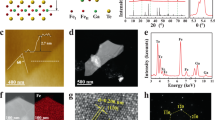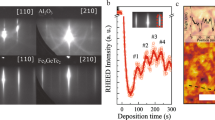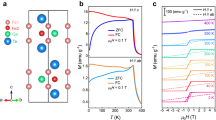Abstract
Discoveries of intrinsic two-dimensional (2D) ferromagnetism in van der Waals (vdW) crystals provide an interesting arena for studying fundamental 2D magnetism and devices that employ localized spins1,2,3,4. However, an exfoliable vdW material that exhibits intrinsic 2D itinerant magnetism remains elusive. Here we demonstrate that Fe3GeTe2 (FGT), an exfoliable vdW magnet, exhibits robust 2D ferromagnetism with strong perpendicular anisotropy when thinned down to a monolayer. Layer-number-dependent studies reveal a crossover from 3D to 2D Ising ferromagnetism for thicknesses less than 4 nm (five layers), accompanied by a fast drop of the Curie temperature (TC) from 207 K to 130 K in the monolayer. For FGT flakes thicker than ~15 nm, a distinct magnetic behaviour emerges in an intermediate temperature range, which we show is due to the formation of labyrinthine domain patterns. Our work introduces an atomically thin ferromagnetic metal that could be useful for the study of controllable 2D itinerant ferromagnetism and for engineering spintronic vdW heterostructures5.
This is a preview of subscription content, access via your institution
Access options
Access Nature and 54 other Nature Portfolio journals
Get Nature+, our best-value online-access subscription
$29.99 / 30 days
cancel any time
Subscribe to this journal
Receive 12 print issues and online access
$259.00 per year
only $21.58 per issue
Buy this article
- Purchase on Springer Link
- Instant access to full article PDF
Prices may be subject to local taxes which are calculated during checkout




Similar content being viewed by others
References
Huang, B. et al. Layer-dependent ferromagnetism in a van der Waals crystal down to the monolayer limit. Nature 546, 270–273 (2017).
Gong, C. et al. Discovery of intrinsic ferromagnetism in two-dimensional van der Waals crystals. Nature 546, 265–269 (2017).
Seyler, K. L. et al. Ligand-field helical luminescence in a 2D ferromagnetic insulator. Nat. Phys. 14, 277–281 (2018).
Bonilla, M. et al. Strong room-temperature ferromagnetism in VSe2 monolayers on van der Waals substrates. Nat. Nanotech. 13, 289–293 (2018).
Zhong, D. et al. Van der Waals engineering of ferromagnetic semiconductor heterostructures for spin and valleytronics. Sci. Adv. 3, e1603113 (2017).
Gradmann, U. in Handbook of Magnetic Materials Vol. 7 (ed. Buschow, K. H. J.) 1–96 (Elsevier, Amsterdam, 1993).
Huang, F., Kief, M. T., Mankey, G. J. & Willis, R. F. Magnetism in the few-monolayers limit: a surface magneto-optic Kerr-effect study of the magnetic behavior of ultrathin films of Co, Ni, and Co-Ni alloys on Cu(100) and Cu(111). Phys. Rev. B 49, 3962–3971 (1994).
Prinz, G. A. Magnetoelectronics. Science 282, 1660–1663 (1998).
Heinze, S. et al. Real-space Imaging of antiferromagnetism on the atomic scale. Science 288, 1805–1809 (2000).
Deiseroth, H.-J., Aleksandrov, K., Reiner, C., Kienle, L. & Kremer, R. K. Fe3GeTe2 and Ni3GeTe2—two new layered transition-metal compounds: crystal structures, HRTEM investigations, and magnetic and electrical properties. Eur. J. Inorg. Chem. 2006, 1561–1567 (2006).
Chen, B. et al. Magnetic properties of layered itinerant electron ferromagnet Fe3GeTe2. J. Phys. Soc. Jpn 82, 124711 (2013).
May, A. F., Calder, S., Cantoni, C., Cao, H. & McGuire, M. A. Magnetic structure and phase stability of the van der Waals bonded ferromagnet Fe3–xGeTe2. Phys. Rev. B 93, 014411 (2016).
Liu, S. et al. Wafer-scale two-dimensional ferromagnetic Fe3GeTe2 thin films were grown by molecular beam epitaxy. 2D Mater. Appl. 1, 30 (2017).
Yi, J. et al. Competing antiferromagnetism in a quasi-2D itinerant ferromagnet: Fe3GeTe2. 2D Mater. 4, 011005 (2016).
Zhu, J. X. et al. Electronic correlation and magnetism in the ferromagnetic metal Fe3GeTe2. Phys. Rev. B 93, 144404 (2016).
Zhang, Y. et al. Emergence of Kondo lattice behavior in a van der Waals itinerant ferromagnet, Fe3GeTe2. Sci. Adv. 4, eaao6791 (2018).
Zhuang, H. L., Kent, P. R. C. & Hennig, R. G. Strong anisotropy and magnetostriction in the two-dimensional Stoner ferromagnet Fe3GeTe2. Phys. Rev. B 93, 134407 (2016).
Mermin, N. D. & Wagner, H. Absence of ferromagnetism or antiferromagnetism in one- or two-dimensional isotropic Heisenberg models. Phys. Rev. Lett. 17, 1133–1136 (1966).
Magda, G. Z. et al. Exfoliation of large-area transition metal chalcogenide single layers. Sci. Rep. 5, 14714 (2015).
Hsu, C. L. et al. Layer-by-layer graphene/TCNQ stacked films as conducting anodes for organic solar cells. ACS Nano 6, 5031–5039 (2012).
Desai, S. B. et al. Gold-mediated exfoliation of ultralarge optoelectronically-perfect monolayers. Adv. Mater. 28, 4053–4058 (2016).
Li, Y. & Baberschke, K. Dimensional crossover in ultrathin Ni(111) films on W(110). Phys. Rev. Lett. 68, 1208–1211 (1992).
Back, C. H. et al. Experimental confirmation of universality for a phase transition in two dimensions. Nature 378, 597–600 (1995).
Liu, B. et al. Critical behavior of the van der Waals bonded high T C ferromagnet Fe3GeTe2. Sci. Rep. 7, 6184 (2017).
Huang, F., Mankey, G. J., Kief, M. T. & Willis, R. F. Finite-size scaling behavior of ferromagnetic thin films. J. Appl. Phys. 73, 6760–6762 (1993).
León-Brito, N., Bauer, E. D., Ronning, F., Thompson, J. D. & Movshovich, R. Magnetic microstructure and magnetic properties of uniaxial itinerant ferromagnet Fe3GeTe2. J. Appl. Phys. 120, 083903 (2016).
Nguyen, G. D. et al. Visualization and manipulation of magnetic domains in the quasi-two-dimensional material Fe3GeTe2. Phys. Rev. B 97, 014425 (2018).
Pierce, M. S. et al. Disorder-induced microscopic magnetic memory. Phys. Rev. Lett. 94, 017202 (2005).
Deutsch, J. M. & Mai, T. Mechanism for nonequilibrium symmetry breaking and pattern formation in magnetic films. Phys. Rev. E 72, 016115 (2005).
Jagla, E. A. Hysteresis loops of magnetic thin films with perpendicular anisotropy. Phys. Rev. B 72, 094406 (2005).
Acknowledgements
The authors thank M. den Nijs for the helpful discussion. The work at the University of Washington is mainly supported by NSF MRSEC 1719797. B.H. and D.X. are supported by Basic Energy Sciences, Materials Sciences and Engineering Division (DE-SC0012509). W.Y. is supported by the Croucher Foundation (Croucher Innovation Award) and the HKU ORA. Synthesis efforts at ORNL (AFM) were supported by the US Department of Energy, Office of Science, Basic Energy Sciences, Materials Sciences and Engineering Division. X.X. and X.Z. acknowledge NSF MRSECs at the University of Washington (DMR-1719797) and the University of Columbia (DMR-1420634) for supporting the exchange visit. X.X. and J.H.C. acknowledge the support from the State of Washington funded Clean Energy Institute and from the Boeing Distinguished Professorship in Physics. Work at Rutgers (W. Wang and W. Wu) was supported by the Office of Basic Energy Sciences, Division of Materials Sciences and Engineering, US Department of Energy under Award number DE-SC0018153.
Author information
Authors and Affiliations
Contributions
X.X., J.H.C. and A.M. conceived the experiment. P.M. and A.M. synthesized and characterized the bulk FGT crystal, assisted by J.S. X.Z. designed the exfoliation on a gold substrate approach. Z.F. and B.H. fabricated the samples, acquired the experimental data, assisted by T.S. and supervised by X.X., J.H.C. and D.C. W.Wang and W.Wu performed and analysed the MFM results. D.X. and W.Y. provided theoretical support. Z.F., B.H., X.X., J.H.C. and D.C. wrote the manuscript with input from all authors. All the authors discussed the results.
Corresponding authors
Ethics declarations
Competing Interests
The authors declare no competing interests.
Additional information
Publisher’s note: Springer Nature remains neutral with regard to jurisdictional claims in published maps and institutional affiliations.
Supplementary information
Supplementary Information
Supplementary Figures 1-6, Supplementary References 1–4
Rights and permissions
About this article
Cite this article
Fei, Z., Huang, B., Malinowski, P. et al. Two-dimensional itinerant ferromagnetism in atomically thin Fe3GeTe2. Nature Mater 17, 778–782 (2018). https://doi.org/10.1038/s41563-018-0149-7
Received:
Accepted:
Published:
Issue Date:
DOI: https://doi.org/10.1038/s41563-018-0149-7
This article is cited by
-
Large anomalous transverse transport properties in atomically thin 2D Fe3GaTe2
NPG Asia Materials (2024)
-
Spin-reorientation driven emergent phases and unconventional magnetotransport in quasi-2D vdW ferromagnet Fe4GeTe2
npj 2D Materials and Applications (2024)
-
Three-stage ultrafast demagnetization dynamics in a monolayer ferromagnet
Nature Communications (2024)
-
Ferrielectricity controlled widely-tunable magnetoelectric coupling in van der Waals multiferroics
Nature Communications (2024)
-
Spin-order-dependent magneto-elastic coupling in two dimensional antiferromagnetic MnPSe3 observed through Raman spectroscopy
npj 2D Materials and Applications (2024)



